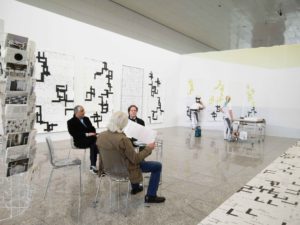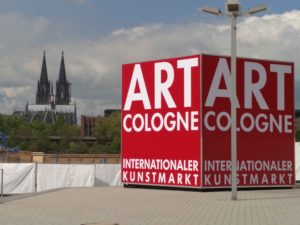Founded in 1967 by two Cologne based gallerists Hein Stünke and Rudolf Zwirner, the Art Cologne is considered as the world’s oldest still existing art fair. Despite its changeful history regarding the name and the location, the Art Cologne celebrated this year its 50th birthday.
Originally called “Kölner Kunstmarkt” (Cologne Art Market), the first event, with only 18 German gallerists, was held in the Cologne Gürzenich, to support the, at this time, weak art market in Germany. Temporarily alternated between Cologne and Düsseldorf, the now named Art Cologne is located at the Cologne exhibition ground since 1984. After a crisis in the early 2000s years, the fair is growing again with its new director Daniel Hug, appointed in 2008.
250 exhibitors participated in this year’s event, thereof 204 galleries from 28 countries. Besides the long-time faithful galleries, the fair could regain exhibitors and acquire new interesting ones like the famous Gagosian Gallery. Furthermore, there were representatives of art journals (inter alia Monopol, Parkett and art), limited art editions and regional art associations (Neuer Aachener Kunstverein, Bonner and Kölner Kunstverein etc.). 52.000 visitors could appreciate works from around 2.000 artists.
 The entrance hall was dominated by the commissioned site-specific installation “L” by Michael Riedel. Based on the transcription of the three-hour admission conference for the fair, the artist isolated the letter “L”, which appeared 1,894 times out of a total of 53,689 characters in the document. On a floor-area of 350 m2 and a booth in L-form, the letter represented the previous communication as complex graphic patterns.
The entrance hall was dominated by the commissioned site-specific installation “L” by Michael Riedel. Based on the transcription of the three-hour admission conference for the fair, the artist isolated the letter “L”, which appeared 1,894 times out of a total of 53,689 characters in the document. On a floor-area of 350 m2 and a booth in L-form, the letter represented the previous communication as complex graphic patterns.
Entering through a second hall with some stands from publishers, the visitor had to decide the direction of the tour: there were three levels with four sections. In the basement was the department for art from the classical modern period and post-war creations, with for example Arp, Léger, Moholy-Nagy and Vasarely. Nevertheless, on view were as well contemporary artists like Candida Höfer and Manolo Valdés and some new positions.
The first floor was reserved for Contemporary Art. Exhibitors like David Zwirner, Max Hetzler and Carolina Nitsch exhibited primarily living established artists, with some exceptions into the 1960s and 1970s and some more new positions than in the basement. On 22.415 m² met inter alia Wolfgang Tillmanns, Tracy Emin and Erwin Wurm alike Sigmar Polke, Lucio Fontana and Per Kirkby.
On the upper floor were the two sections Neumarkt and Neumarkt Collaborations. The name of this department is well chosen. Neumarkt means in German new market, so it is the right place to be for “cutting edge art”, be it in the sense of emerging newcomers or according to the age of the galleries, which were maximal ten years old. In addition, the “Neumarkt” in the south of the historical centre of Cologne is the largest square of the city. It is deeply interwoven with Cologne’s history and the present. Be that as transport hub, shopping mall or central meeting point, for example during the Cologne carnival. Furthermore, museums, galleries and other cultural institutions have their domicile here.
At the Neumarkt of the fair, there were the young exhibitors with their, often not yet established creators. The Collaborations developed synergies between different galleries and/or two or more artists. Moreover, editors and regional art associations were present.
In this sense and according to Daniel Hug, the promotion of the German art market is still an objective, especially because numerous “normal” art collectors are domiciled here, not the very rich who are typically buying at the Art Basel or Frieze. Besides, there are many notable artists, galleries and art institutions, located in Berlin and the whole country. However, in the Rhineland the long tradition of art creation, collecting and supporting is very lively. That makes the Art Cologne particularly interesting, without the claim to get in competition with the huge international art fairs.
















































































































